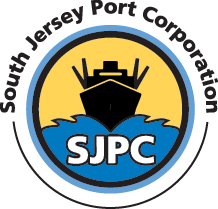The final numbers are in and the South Jersey Port Corporation closed out 2021 with an all-time record-breaking cargo volume of 4,636,097 tons, a 54% increase over 2020, breaking the previous record by 6%.
“That’s the best in the history of the South Jersey Ports and we’re expecting 2022 to be a very strong year that may top 2021,” reported Andy Saporito, Executive Director and CEO of South Jersey Port Corporation at the monthly meeting of the Board of Directors. “This milestone is a testament to the skilled workers and partners who keep goods moving through the supply chain while our team seeks solutions to improve efficiency, attract business and build for the future. The ongoing collaboration with SJPC’s labor force and industry partners lifted the port to this extraordinary record during the challenging time of the Covid-19 pandemic,” said Saporito.
The dramatic increases in tonnage came from nearly all the SJPC’s prime cargo sectors: steel, plywood, recycled metals, cocoa beans, cement, and gypsum. The lone laggard, sand exports, is expected to increase as the national infrastructure plan is implemented.
Rebounding steel imports led the way with 2,399,076 tons, a 141% increase over 2020. The majority of this increase occurred at the Paulsboro Marine Terminal which moved 1,760,018 tons of steel slabs. Plywood import tonnage increased by 98% totaling 220,812 tons demonstrating the Camden terminals as a premiere plywood portal on the East Coast. Cocoa beans totaled 76,108 tons, a 36% increase verses 2020 totals. Exports of recycled metals increased by 10% and cement increased by 8%.
The number of ship days was 960 days compared to 549 ship days in 2020, a 75% increase. “Ship days is the number of days a ship is loading or unloading at its terminal” explained Kevin Duffy, Assistant Executive Director / Chief Operating Officer. “We’ve worked hard to ensure we continue to operate safely and efficiently to move the increased cargo and have space to meet our customers’ needs”.
Brendan Dugan, Assistant Executive Director / Director of Business Development, expects the cargo activity at South Jersey Ports to remain strong for the foreseeable future due to the national infrastructure plan and New Jersey’s leadership role in the $109 billion offshore wind industry. EEW Group, which is building a $300 million manufacturing plant at the Paulsboro Marine Terminal to provide the massive steel monopiles for the offshore wind farms along the entire eastern seaboard, will ultimately require 150,000 tons of imported steel annually to meet their customers’ demand. To build on this momentum, SJPC is conducting a study of the Port of Salem, which is a smaller port just down river from Paulsboro that could become an important supply port for the local offshore wind support services industry.
“The challenge is to build the infrastructure to grow the port while operating more efficiently to meet current demands,” said Dugan. South Jersey Ports received a $6 million grant to upgrade the rail infrastructure at one of their Camden terminals and a $9 million grant for wharf infrastructure improvements at the Salem Terminal. “We identified an old building that we might refurbish to put another 40,000 square feet of storage space online and meet long-term customer demands.”
“We continue to focus on upgrading technology and automation to optimize the fluid movement of cargo through our terminals and to ensure our customers’ storage and inventory needs are met”, added COO Kevin Duffy.
The South Jersey Port Corporation was created in 1968 to operate marine shipping terminals in the South Jersey Port District, consisting of seven counties: Burlington, Camden, Gloucester, Salem, Cumberland, Mercer, and Cape May. The South Jersey Ports is a national leader in bulk and breakbulk cargo, shipping and receiving to and from Africa, Asia, Latin America and Europe. Their four international seaport facilities in South Jersey handle more than four million tons of bulk, breakbulk and containerized cargoes annually.



